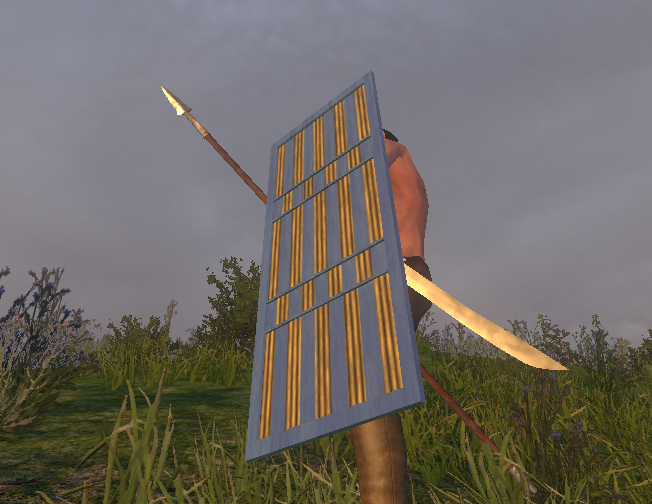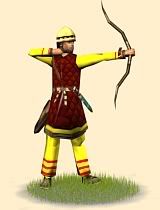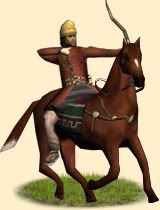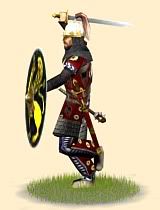This will be a priority to add.
Kamandaran-i Shahvar (Royal Archers)
The Sassanians relied heavily on their archers, The Sassanian infantry formed at least two-thirds of any Persian army that included any foot. The elites were archers, firing from behind a wall of shields, while ordinary infantry were spearmen, equipped from government armories. There are interesting reports that foot archers are capable to both shoot backwards when retreating, a feat remembering the fammous Parthan shot of horse archers, and fight the enemy in close combat. Such foot archers are an elite and much better equipped the standard archer. Another famous unit are the Royal Foot Archers, a small cadre of some 100 men. They are supposed to defend the throne to the death.\was one battle where foot archers distinguished themselves. It was 542 AD at Anglon, where an Iranian force of some 4,000 troops defeated a Byzantine army of some 30,000 troops. The Iranian lured the Byzanine into the town, where they had prepared fortified positions and hidden cabins. They poured missile volleys from multiple directions at the Byzantines, who could not organize proper countermeasures. The Byzantines were resoundly defeated and many were captured, when they tried to flee in panic.

Saka Cavalry
The Saka were an Iranian speaking peoples of Aryan (Indo-Iranian) Stock. They are considered to be a branch of the Scythians by most scholars, and closely related to the Cimmerians. Being Scythians, they are as much a horse people as their neighbors. They are tough, very capable fighters, preferring a mix of kontos and bow like most other steppe peoples.

Deylam Sagaris Axemen
The sagaris is an ancient waraxe used from the time of ancient Greece, the surrounding peoples have similar versions or copies of this very effective and brutal weapon. The Deylamites (Daylamites/Dimli/Dimili) were known for their skirmishers and their use of the war-axe.\n\nThe Deylamite Infantry is considered as one of the best infantry in the middle east, if not the best. Roman sources have spoken highly of the Deylamites`s skills and hardiness in close combat with sword and dagger. The Arab scholar Muqaddasi reported that Dailam was ‘neither too big, nor too beautiful’. The Arab historians wrote that the Dailamites were a strong and numerous race, renowned for its extraordinary courage and its great endurance, and whose representatives had a good looking, commanding appearance and handsome beards. An Arab source calls the Dailamites ashqar ‘a rosy colour’. The long and disordered hair of the Dailamites has at all times produced fresh metaphores of the poets who mentioned their black skull caps just as often.
Deylamite Infantry
Recruited from the mountainous Deylam area of northern Iran, the Deylamite (Daylamites/Dimli/Dimili) Infantry is considered as one of the best infantry in the middle east, if not the best in the Iranian army. Roman sources have spoken highly of the Deylamites`s skills and hardiness in close combat with sword and dagger. \n\n Their weapons included battle axe, heavy sword, sling, dagger. As missile weapons they use a short two-pronged spear, which could either used in hand-to-hand combat or be hurled in manner of Roman legionnaires. Shields are brightly painted. The Muslim Arabs of the 7th century proved unable to subdue the Dailamites. Whenever Dailamites joined the Muslim army they were eagerly welcomed by the Arabs into their ranks, who would often pay them more than Arab troops.
Sassanian Infantry(NAME NEEDS TO BE CHANGED)
The Sassanids, as much as other civilized army at the time, relied a lot on infantry. Many have mistaken the low-quality Paighan with Sassanian regular infantry. Though the Sassanian cavalry are more well known, the role of the Sassanian regular infantry is at times thought of as equal to Roman Legionnaires. \n\nIn battle they initially stand behind the foot archers, who will retire behind the heavy infantry ranks after their missile supplies are exhausted. Then the heavy infantry will engage in hand-to-hand fighting. Another successful tactic is to place them behind the Savaran, they would advance in coordination with them. As soon as the Savaran are about to reach enemies lines they will retire to the left and right wings. That would allow the heavy infantry to close in and engage the enemy infantry. That would surprise the enemy, who expects an cavalry charge, and pin down him so that the Savaran could attack the now vulnerable flanks. They are a professional corps of fighters who can be expected to stand in a battle line and behave with great courage but their equipment is certainly not equal to the cavalry. Nethertheless the Iranians excelled in archery and cavalry and could never fully matched Roman expertise in infantry.
Han has represented these units below in his latest developers update Will add when descriptions are accurately applied
{cataphracts} Peroozetae
Another of the Royal Guards units, the Peroozetae ("Victorious Ones") are Clibinari lancers. They are equipped with a heavy kontos, some melee weapons and a shield. Experts in powerful lance charges they are best used as assault troops breaking up enemies formationes. \n\nThe Romans (and later the Byzantines) developed countermeasure such as counterattacking them from the flanks. The Strategikon of Emperor Maurice recommends such tactics due to the risk that the Romans would suffer injury on running into their well ordered ranks.\n\n Less is known about them but it was reported that one Savaran member of the Peroozetae rescued his King, when he cut a noose, that had caught the King`s horse. \n\nEastern peoples have long used heavily armoured - in this case completely armoured - horsemen in battle. Long before the Sassanid dynasty took control, the Parthians had perfected these 'iron warriors' as part of a supreme battle-winning force.Clibinarii are not a perfect answer to every tactical situation. They are superb for grinding down enemy formations, but they cannot be used for more 'traditional' cavalry duties such as pursuit and screening. They are an iron fist inside an iron glove, ready to pummel enemies into submission.
{armoured_camel_riders} Savaran
Among the Iranian warrior caste the Savaran knights are the elite and holds a special position of honour in the Sassanian Spah (army). First, only nobles of both the seven Great Clans and the Azadans formed their ranks. Later, after King Khosrow I. (532-579 AD) reforms, the lower Dehkan nobililty were allowed to enter the ranks of the Savaran and so increased the available manpower of Imperial forces. \n\nThe Savaran are the forerunners of medieval knights, their influence in development of weaponry, battle tactics and costumes for Romano-Byzantines and medieval Europe was great. \n\nEach Savaran units seems to have had their own banner and coat of arms (the Drafsh). Drafsh could either be flown as banners or worn as insignia by the Savaran. The Drafsh are displayed on a crosspole or –pole, however shield bosses and tunics could display them, either. There are many different banner designs with lions, tigers, gazelles, boars, wolves and mythological beasts. The Draco flags is especially popular.\n\nSavaran are heavy cavalry, belonging to the cataphracts, with both man and horse protected by high quality armour. Though Savaran are not the answer to every tactical problem, they are true universal cavalrymen, well-versed in both archery and melee weapon. They can weaken their enemies with showers of arrows till they close and attack with lance, sword and mace. But they have to fear well-trained spearmen and more mobile horse-archers such as steppe nomad horse archers with their powerful composite bows.
{clibinarii_immortals} Pushtigban
The Pushtighban are the Royal bodyguard unit of the Sassanian Kings. Numbering perhaps 1,000 men they are the elite of the elite. Many members stern from the Great Clans or are other high ranking nobles of the Iranian feudal society and their loyality is unquestionable. \n\nThey are enceased completely in iron mail with protective lamellar and laminated armor underneath as well as armored gloves. The tight fitting face masks have holes and slits for nose and eyes as well as protective mail behind and around the neck. Each knight carries a large kontos, a heavy sword, mace and axe. These “Iron-clad men” have no need for shields. \n\nThe horse has has heavy armor protection for its legs and body. It was reported that some men had to lift up the warrior onto the saddle due to the immense weight of the armor. Only the famous Nisean horse bred could carry such a weight into battle. \n\nIt was written that these knight were so strong, that they could impale two enemies simultaneously. A certain countermeasure of the Romans against these “iron-clad men” was they tried to dive underneath the steed and stab its belly. The fallen knight was almost defenseless due the weight of his armor. Against the far more mobile and flexible steppe nomads equipped with powerful composite bows as the Hephtalites the superheavy knights often meet desaster if they are being left unsupported. \n\nThey are superb for grinding down enemy formations, but they cannot be used for more 'traditional' cavalry duties such as pursuit and screening. They are an iron fist inside an iron glove, ready to pummel enemies into submission.
{clibinarii} Zhayedan
Zhayedan (“Immortals” in Pahlavi ), the most famous and most known of the Royal Guards units. They are super-heavy cavalry, with both men and horses armoured from head to toe. They were elite shock troops, intended to close in as fast as possible and wear down the enemy with powerful lance charges and and brutal melee attacks.\n\nHistorically a force of 10,000 men, they are an elite within the Sassanian army. Only few selected Savaran veterans, who had proved them exceptionally in battle, were allowed to join the Zhayedan. Their task was to secure any breakthrough, and they were often held as reserve force, entering the battle at crucial stages.\n\nThey are the revival of the Achaemenid Immortals and so it is highly probably that their uniforms and insignia reflected Achaemenid tradition. Their commander bore the title of Varthragh-Nighan Khvadhay and often was a Prince of the Royal family. \n\nEastern peoples have long used heavily armoured - in this case completely armoured - horsemen in battle. Long before the Sassanid dynasty took control, the Parthians had perfected these 'iron warriors' as part of a supreme battle-winning force.Clibinarii are not a perfect answer to every tactical situation. They are superb for grinding down enemy formations, but they cannot be used for more 'traditional' cavalry duties such as pursuit and screening. They are an iron fist inside an iron glove, ready to pummel enemies into submission.















 Reply With Quote
Reply With Quote




























